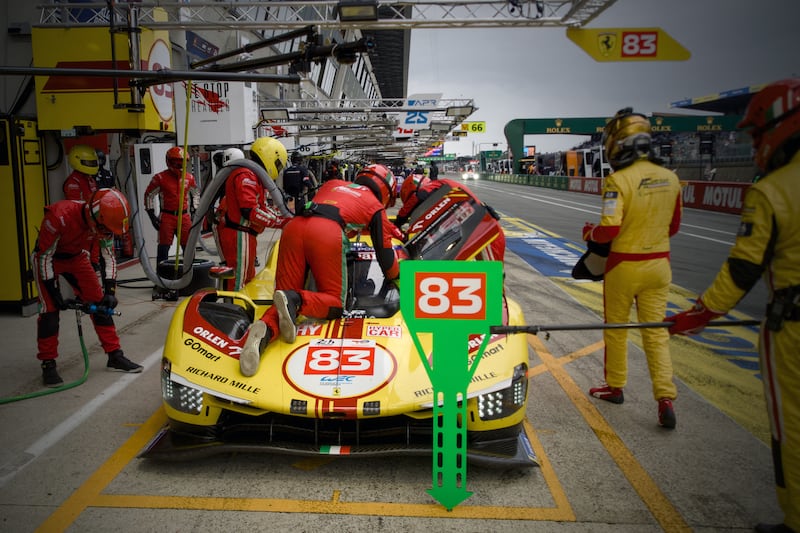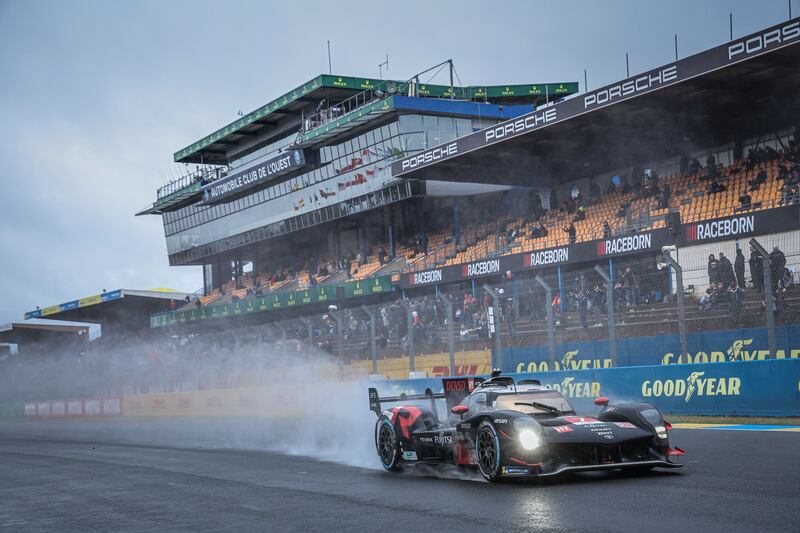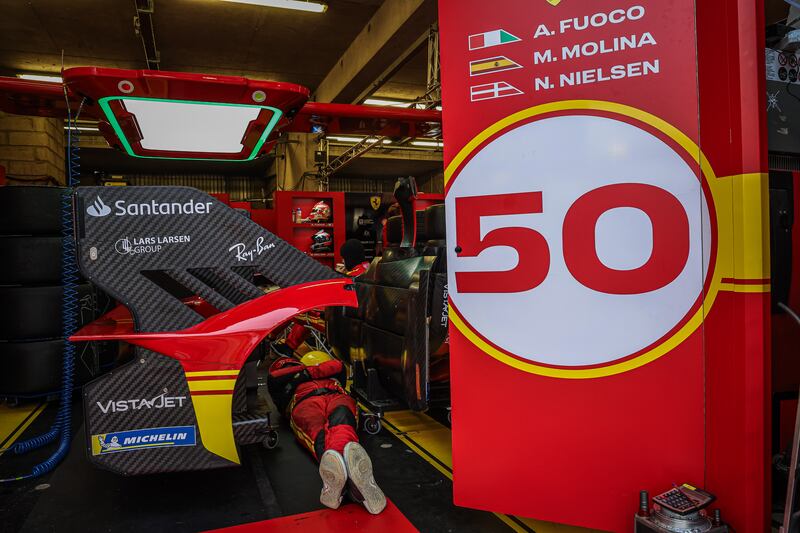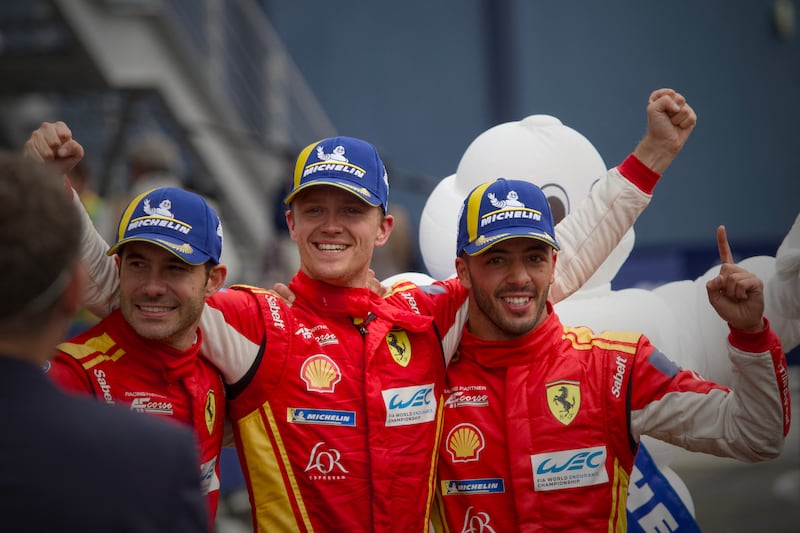I feel as if I have become a part of the Circuit De La Sarthe, the 13km mix of public road and private racing track that is home to — arguably — the greatest race of them all: Le Mans.
Currently, my shoes are caked in the mud and grime of its paddock. My face and hair are both damp from the lineup of sudden showers and the sunblock that needed to be rapidly applied as the sun broke through the clouds at times. My ears are ringing with the sound of engines and my socks are squelching. It’s fair to say that the 24hrs of Le Mans is not a motor race that one merely attends. You have to take part in your own private test of endurance to watch it.
Once, endurance really was the name of the game. The 100 year old Bentley, which chugged happily up the start-finish straight to deliver the winner’s trophy before the start of the race — the same car which, a century ago, won this event on this circuit — had to be nursed and occasionally bandaged to reach the finish. Now, and since the early 2000s, technology has reached such a peak that Le Mans racers no longer have to be coddled to reach the end of the 24hrs — they are raced flat out against one another, against the clock, against the weather, and against the whims of the race itself. As former winner Alexander Wurz wryly notes, you don’t win Le Mans — Le Mans chooses you to win.
Last year, on the 100th anniversary of the first 24hrs, Ferrari returned from a 50 year absence at the front of the field, to take a win about which many were slightly sniffy. The Balance Of Performance — BOP, the rules that allow Le Mans’ governing body to add weight to and subtract power from individual cars to ensure close racing — had been fiddled in Ferrari’s favour to ensure a glamorous, anniversary-appropriate win. It was probably just sour grapes, but it certainly tarnished the victory of the red cars last year.
READ MORE

This year there can be no such doubt. Whatever the machinations of the organisers, Ferrari was facing a packed grid of similarly-powerful ‘Hypercars’ — hybrid racers which appear to have landed from another planet — from Porsche, Toyota, Peugeot, Alpine, Cadillac, and BMW (returning this year for the first time since 1999) as well as Lamborghini. In all, between works teams and private entries, 23 Hypercars took the start, a record top-class entry not seen since the glory days of the 1980s. More are keen to follow. Aston Martin will enter the Hypercar category next year, and the likes of Honda, Jaguar, and Mercedes are oft-rumoured.
Ferrari wasn’t given all that much of a chance in the run up to the big event. Not was Toyota, in spite of it having won so many times here, and in spite of its car looking quite simply like the baddest, meanest thing out there. Porsche was, in general, expected to finally add that 20th win to record books, and the big challengers were supposed to have been Cadillac and BMW, which put in a surprisingly rapid performance in testing and qualifying.

From the start, though, Ferrari leapt into the lead ahead of the fastest Porsche, even if it was often the independently-run AF Corse car which made much of the early running for the Prancing Horse. Indeed, it probably would have been the No.83 AF Corse Ferrari which would have won this race, but for a late calamitous hybrid system failure in the pits, which saw it ignominiously retired.
The race, with this many top-line competitors, was always going to be topsy-turvy but the weather became the dominant factor. Against forecasts which had predicted largely cool and dry conditions for most of the race, the Loire Valley decided to toy with the team (and, for that matter, the mere onlookers) with sudden squalls of rain and wind, which forced teams to gamble on whether or not to fit wet weather tyres or to try and sit it out on slick tyres. This the race swung wildly between Porsche, Cadillac, Toyota, and Ferrari. But mostly Ferrari.
Two lengthy safety car periods — one to fix a smashed section of barrier, against which BMW’s hopes for a strong finish ended in the late evening — and one because heavy rain made it simply too dangerous to race at flat out speeds — kept eliminating the leads which some drivers were pulling out over their rivals, bunching up the pack and turning the event into a series of dramatic, close-quarter sprints.

No more closely quartered than then Toyota’s Jose Maria Lopez tried a daring lunge up the inside of the second placed Ferrari at Dunlop, the first corner. The two cars actually touched, and traded paint between their side panels. Lopez finished the manoeuvre further along the track, down the fabled Mulsanne Straight. It was a dramatic, thrilling moment at a time when Lopez was taking big chunks out of the lead of the No.50 Ferrari but it was for naught at Lopez later had a spin on the slippery, rain-slicked surface and gave the advantage back to Ferrari.
Further back in the pack, the pair of Peugeot 9X8 cars — easily the most striking of the race cars to look at — proved not fast enough to challenge for victory. This despite a major change of aerodynamic thinking on the car between this year and last, but at least Peugeot can be proud that it brought both cars home, although its drivers did occasionally blot their copybooks with yellow flag infringements and a spin.

Still, both cars to the finish at all is no mean feat, and it was unlike its French rivals at Alpine, which saw both of its cars out before dawn broke on Sunday (a shame — their distinctive ‘whooping’ engine notes were an aural highlight of the race, although the the sheer thunder of the Cadillac V8 engine took the prize for best noise). Lamborghini also ran well, but was not fast enough to challenge the faster cars while Porsche’s customer teams — Jota, whose gold Hertz livery was the best-looking colour scheme— and Proton faded after early showings.
Further back, the renewed GT3 class for road-based cars saw some much-needed variety in the entry. Joining previous class stalwarts Porsche, Ferrari, Aston Martin, and Corvette were Ford, Lamborghini, BMW, and McLaren. McLaren scored the pole position for the class in qualifying — the brand’s first Le Mans pole, to go with its singleton win in 1995 — and the new Ford Mustangs ran well, and made a noise beaten only by Cadillac, but final victory in the class when to the Manthey-run Porsche 911, a car which had seemed almost slow in the early hours, but which steadily and stealthily worked its way into an unassailable lead by the flag.

Ferrari’s win was not so easy. Penalties for leading cars — one for tapping one of three BMWs into a race-ending spin, one a recall to the pits to fix a flapping, open door — gave Porsche, Cadillac, and Toyota opportunities to exploit, and another early morning safety car brought the pack back together again for a final dash to the chequered flag. At times it seemed as if Ferrari was sunk, and Toyota’s combo of nous and speed was going to do the job, but then Lopez had his spin, and the other Toyota — the No.8 car — just didn’t have enough laps left to chase the red car down.
So Ferrari wins a second Le Mans on the trot, with Antonio Fuoco, Niklas Nielsen, and Miguel Molina equalling the efforts of their team-mates — Antonio Giovanazzi, James Calado, and Aleessandro Per Guidi — from last year. There can surely be no arguing about sneaky advantages from rule changes this year. The fight was just too hard.
What you take away from Le Mans — I mean aside from the mud, the squelchy socks, and the faint ringing in the ears — are snatched moments. The fanfare of Le Marseillaise before the start and the dramatic delivery of the starter’s official flag (waved by Zinedine Zidane no less) from a hovering helicopter. The piercing lights of the cars as they approach you during the night. The intoxicating speed with which they whip past your nose on entry to the first chicane on the Mulsanne. The fireworks. The death-or-glory piloting of the TV camera helicopters. The sheer magic of being, for those 24hrs, at the epicentre of the racing world. It’s far more than a mere motor race.
With many thanks to the Peugeot Sport Total Energies team.














